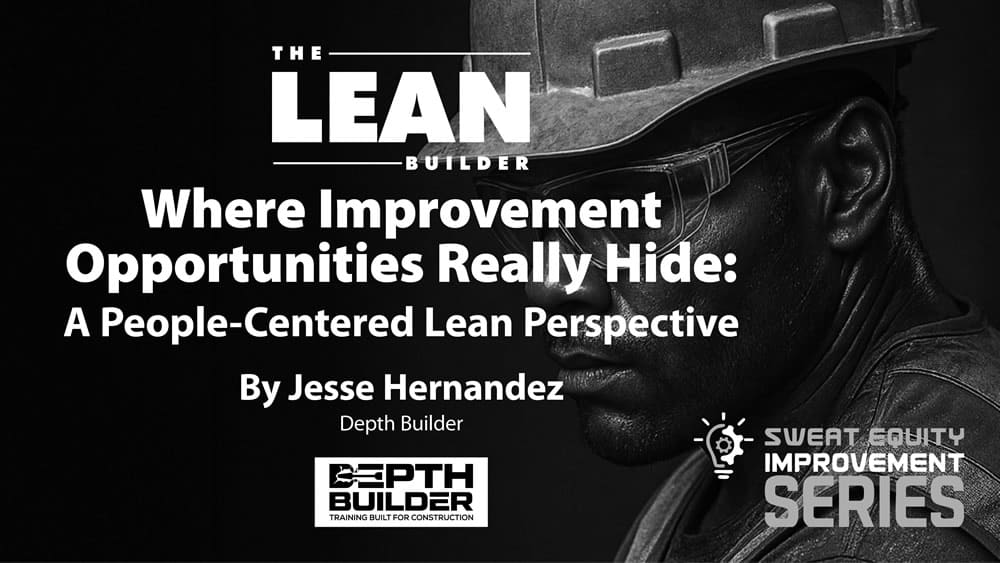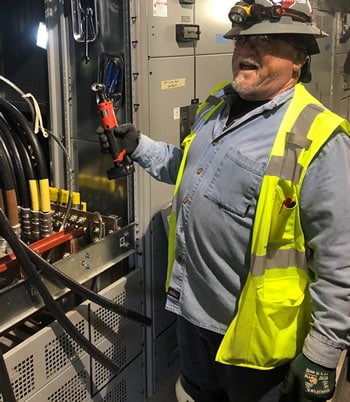In this five-part blog series, I’ll introduce you to the concept of Sweat Equity Improvement (SQI). I’m on tap to drop one blog a month in a quest to help you eliminate the life-stealing, unprofitable work. Let’s go.
Walk any construction jobsite and you’ll see motion everywhere. Tools in hand. Crews moving material. Installers working at a steady pace. From a distance, it looks like productivity.
But here’s the catch: activity isn’t always production.
That’s one of the biggest lessons I learned when I began practicing Lean Construction. Early in my career, I thought my job was to push crews to go faster. I’d walk the site, make lists of what they were doing wrong, and tell them how to “work smarter.” The result? They dreaded seeing me coming. I wasn’t building trust — I was eroding it.
Everything shifted when I slowed down enough to study the work at the level of hands and eyes. That’s where the real improvement opportunities hide — not just in the schedule or the logistics, but in the way individual men and women actually perform their tasks.
The “Micro” Level of Lean
Lean advocates are familiar with big tools: pull planning, Last Planner System, weekly work plans, value stream maps. These are powerful, but they can blind us to the smaller — and often more impactful — details.
Take, for example, Odie, a sheet metal mechanic I studied on a project. Her task was simple: cut hanger strap and all-thread. Nothing fancy. No high-dollar equipment. Just steady, repetitive work.
From a manager’s perspective, Odie was performing just fine. She was working consistently, not slacking off, and turning out what was asked. But when we broke her process into steps, the hidden waste leapt off the page:
- Cutting three straps, then dropping them on the floor.
- Walking back and forth between her cart and workstation.
- Bending over repeatedly to pick up cut pieces.
- Tucking snips under her arm while juggling material.
Individually, each motion looked harmless. Together, they added up to hundreds of wasted steps, unnecessary strain, and real wear-and-tear on her body.
And here’s the kicker: those “small” inefficiencies were costing the project minutes per cycle, multiplied across hundreds of repetitions, multiplied across multiple crews.
Seconds Compound into Hours
When I presented my observations, one superintendent brushed it off: “Jesse, you’re talking about a minute and 23 seconds. Who cares?”
Here’s why it matters:
- One cycle saved 83 seconds.
- Odie performed that cycle dozens of times a day.
- The project had four floors doing the same work.
What looked like “just a minute” became hours of labor and thousands of dollars over the life of the project.
Lean practitioners already know the principle: small improvements multiplied across high-frequency tasks equal massive gains. But the real breakthrough isn’t just the math — it’s the human side.
The Human Side of Improvement
When we redesigned Odie’s setup — a table with a mounted strap roll, a ruler for measuring, and storage arms for all-thread — she didn’t just produce more. She smiled. She told me, “I’m glad somebody listened. I can get more done, but it’s also just easier on me.”
That’s the piece too many leaders miss. Improvement isn’t about squeezing more output from tired bodies. It’s about showing respect by removing the “life-stealing” parts of the job: the bending, twisting, overhead work, and awkward reaches that wear people out.
That shift matters. When crews see leaders investing in making their work easier, not just faster, trust grows. Engagement grows. Retention grows.
Because let’s be honest: in today’s labor market, our people have options. The companies that win the attraction and retention game are the ones whose superintendents and project managers consistently demonstrate care for the workforce.
Why a People-Centered Lean Perspective Works
Think about your own body. Drop your keys on the floor. At age 25, no problem. At age 55, you hold your breath, grab your knee, and grunt to pick them up. Multiply that by thousands of repetitive motions across a 20-year career, and you’ve got worn-out knees, busted shoulders, and a shorter work life.
Now apply that lens to your crews:
- Every time they work overhead, it eats away at shoulders.
- Every time they kneel, it chips away at knees.
- Every time they walk unnecessary distances, it saps energy they could use for value-added work.
By focusing on these “nano” details, you’re not just chasing productivity. You’re enhancing longevity. You’re giving people the chance to go home with enough energy to play with their kids or help with dinner — not collapse in the La-Z-Boy.
That’s what Ruben, a veteran electrician, told me after we applied some simple improvements to his work late in his career. He said, “Last night was the first night I went home and didn’t pass out in the chair. I played with my grandkids. If I’d been doing work like this my whole career, I’d have 10 more years left.”
You can’t buy that kind of loyalty. You can only earn it.
Practical Steps to Spot Hidden Opportunities
Ready to try it on your site? Here’s a simple exercise:
- Get permission. Tell a crew member you’d like to study their work so you can help make it easier. Emphasize you’re not there to judge.
- Watch closely. Spend 5–10 minutes observing one individual. Write down every step in your own words.
- Look for strain. Highlight steps that involve bending, twisting, carrying, or repeating awkward motions.
- Brainstorm with them. Ask: “If we could make this easier, what would help?”
- Act immediately. Even if it’s as simple as moving a trash can closer, do something right away. Small wins signal you’re serious.
That’s Lean at its best: not a poster on the wall, but a superintendent or PM side-by-side with their people, making work easier in real time.
A Competitive Advantage in Retention
Construction leaders everywhere are struggling with labor shortages. Projects are won faster than crews can be staffed. Every lost foreman, every burned-out journeyman, every apprentice who decides “this isn’t worth it” is a blow.
If you want to attract and keep talent, start by showing — not just telling — that you value the people doing the work. That means making their work less physically punishing, more efficient, and more dignified.
Lean gives us the tools. People-centered leadership gives us the heart. Together, they create projects where production goes up, and turnover goes down.
Closing
So, where do improvement opportunities really hide? Not in another spreadsheet. Not at another meeting. They hide in the small, daily motions of the men and women on your jobsite.
The leaders who notice — and act — are the ones who win both in performance and in people.
If you’d like to learn more about how to spot and act on these hidden opportunities, join us for the next SQI Micro Dose. It’s a practical, people-first introduction to Sweat Equity Improvement — designed for construction leaders who want to deliver better projects by building up their people.
That’s it for this initial blog in my SQI series. I’ll be back next month with the second installment.










